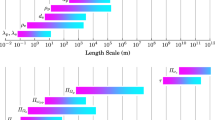Abstract
The longitudinal magnetic field measured using the Fe I λ 525 and Fe I λ 524.7 nm lines and global magnetic field of the sun differ depending on the observatory. To study the cause of these discrepancies, we calculate the H ‖(525)/H ‖(524.7) ratios for various combinations of magnetic elements and compare them with the corresponding observed values. We use the standard quiet model of the solar photosphere suggesting that there are magnetic fields of different polarities in the range between zero and several kilogauss. The magnetic element distribution is found as a function of magnetic field strength and the parameters of this distribution are determined for which the calculated H ‖(525)/H ‖(524.7) ratio agrees with the observed one. The sigma-components are found to be shifted differently for various points of the Fe I λ 525 nm profile calculated for the inhomogeneous magnetic field. The farther the point is from the line center, the larger the sigma-components shift. Such a peculiarity of the profiles may be responsible for the discrepancies in the measured values of the global magnetic field obtained at different observatories. The increase in modulus of the global magnetic field during the maxima of solar activity can be due to a larger fraction of magnetic elements with kilogauss magnetic fields.
Similar content being viewed by others
References
E. A. Baranovskii and T. T. Tsap, “Thin Structure of Solar Magnetic Fields,” Izv. Krym. Astrofiz. Observ. 106, 75–81 (2010).
V. A. Kotov, “On One Paradoox of Magnetic Solar Field Measurements,” Izv. Krym. Astrofiz. Observatorii 104(1), 109–130 (2008).
V. A. Kotov and T. T. Tsap, “On Measuremet Quality of General Magnetic Field of the Sun: Facts, Problems, Hypothesis,” Izv. Krym. Astrofiz. Observ. 101, 82–97 (2005).
D. N. Rachkovskii and T. T. Tsap, “Study of Magnetic Fields by Method of Relationship of Measured Tensions in Lines beyond Active Regions on the Sun,” Izv. Krym. Astrofiz. Observ. 71, 79–87 (1985).
D. N. Rachkovskii, T. T. Tsap, V. G. Lozitskii, and U. M. Leiko, “Diagnosis Problems of Small-Scale Magnetic Fields on the Sun,” Izv. Krym. Astrofiz. Observ. 103(4), 26–35 (2007).
A. B. Severnyi, “On the Nature of Magnetic Fields on the Sun (Thin Field Structure),” Sov. Astron. 9, 171 (1965).
A. B. Severnyi, “Magnetic Field on Different Depths in Solar Atmosphere,” Sov. Astron. 10, 367 (1966).
A. B. Severnyi, “Calibration of Magnetic Field Signals of Solar Magnetograph,” Izv. Krym. Astrofiz. Observ. 36, 22–50 (1967).
A. J. de Wijn, J. O. Stenflo, S. K. Solanki, and S. Tsuneta, “Small Scale Solar Magnetic Fields,” Space Sci. Rev. 144, 275–315 (2009).
O. Gingerich, R. W. Hoyes, W. Kalkofen, and Y. Cuny, “The Harvard Smithsonian Reference Atmosphere,” Solar Phys. 18, 347–365 (1971).
J. Harvey, “Solar Magnetic Fields—Small Scale,” Publ. Astron. Soc. Pacif. 83, 539–549 (1971).
J. Harvey and W. Livingsto, “Magnetograph Measurements with Temperature Sensitive Lines,” Solar Phys. 10, 283–293 (1969).
H. Lin, “On the Distribution of the Solar Magnetic Fields,” Astrophys. J. 446, 421–430 (1995).
B. W. Lites, “Characterization of Magnetic Flux in the Quiet Sun,” Astrophys. J. 573, 431–444 (2002).
C. E. Parnell, C. E. Deforest, H. J. Hagenaar, et al., “Quiet Sun: A Comparison of MDI and SDT Fluxes,” Publ. Astron. Soc. Pacif. 397, 31–41 (2008).
B. Ruiz Cobo and Iniesta J. C. del Toro, “Inversion of Stokes Profiles,” Astrophys. J. 398, 375–385 (1992).
A. B. Severny, “Solar Magnetic Fields,” Space Sci. Rev. 3, 451–486 (1964).
J. O. Stenflo, “Magnetic Field Structure of the Photospheric Network,” Solar Phys. 32, 41–63 (1973).
A. Vögler and M. Schüssler, “Studying Magneto-Convection by Numerical Simulation,” Astron. Nachr. 324, 399–404 (2003).
A. Vögler, S. Shelyag, and M. Schüssler, “Simulations of Magneto-Convection in the Solar Photosphere. Equations, Methods, and Results of the MURaM Code,” Astron. Astrophys. 429, 335–351 (2005).
E. Wiehr, “A Unique Magnetic Field Range for Nonspot Solar Magnetic Regions,” Astron. Astrophys. 69, 279–284 (1978).
Author information
Authors and Affiliations
Corresponding author
Additional information
Original Russian Text © E.A. Baranovskii, T.T. Tsap, 2012, published in Kinematika i Fizika Nebesnykh Tel, 2012, Vol. 28, No. 1, pp. 34–44.
About this article
Cite this article
Baranovskii, E.A., Tsap, T.T. Studies of magnetic fields in the solar photosphere using the line-ratio method. Kinemat. Phys. Celest. Bodies 28, 21–26 (2012). https://doi.org/10.3103/S0884591312010047
Received:
Published:
Issue Date:
DOI: https://doi.org/10.3103/S0884591312010047




